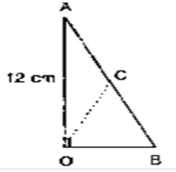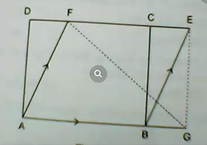In fig.45, ABC,AB=3cm,BC=4cm and AC=5cm. name the smallest and the largest angles of the triangle.
To solve the problem of identifying the smallest and largest angles in triangle ABC, where AB = 3 cm, BC = 4 cm, and AC = 5 cm, we can follow these steps:
1. Identify the sides of the triangle:
- We have three sides: AB = 3 cm, BC = 4 cm, and AC = 5 cm.
2. Determine the longest side:
- Among the sides, the longest side is AC, which measures 5 cm.
3. Identify the angle opposite the longest side:
- The angle opposite to side AC is angle B. Therefore, angle B is the largest angle in the triangle.
4. Determine the smallest side:
- The smallest side is AB, which measures 3 cm.
5. Identify the angle opposite the smallest side:
- The angle opposite to side AB is angle C. Therefore, angle C is the smallest angle in the triangle.
6. Summarize the findings:
- The largest angle is angle B, and the smallest angle is angle C.
Final Answer:
- Largest Angle: Angle B (opposite to side AC)
- Smallest Angle: Angle C (opposite to side AB)
---
- We have three sides: AB = 3 cm, BC = 4 cm, and AC = 5 cm.
- Among the sides, the longest side is AC, which measures 5 cm.
- The angle opposite to side AC is angle B. Therefore, angle B is the largest angle in the triangle.
- The smallest side is AB, which measures 3 cm.
- The angle opposite to side AB is angle C. Therefore, angle C is the smallest angle in the triangle.
- The largest angle is angle B, and the smallest angle is angle C.
- Largest Angle: Angle B (opposite to side AC)
- Smallest Angle: Angle C (opposite to side AB)
Topper's Solved these Questions
Similar Questions
In Figure, ∠AOB=900, AC=BC, OA=12 cm and OC=6.5cm. Find the area of AOB.

View SolutionTriangle ABC is right angled at A.AD is perpendicular to BC. If AB=5 cm, BC=13 cm and AC=12 cm. Find the area of ABC. Also, find the length of AD.
View SolutionIn Figure, ABCD is a rectangle with sides AB=10cmandAD=5cm Find the area of EFG

View SolutionIn a triangle, P, Q and R are the mid-points of sides BC, CA and AB respectively. If AC=21 cm, BC=29cm and AB=30cm, find the perimeter of the quadrilateral ARPQ
View SolutionIn Fig.38, ABCD and PQRC are square such that AD=22 cm and PC=y cm. If the area of the shaded region is 403 cm2, then the value of y is (a)3 (b) 6 (c)9 (d) 10
View SolutionAB and CD are two parallel chords of a circle with centre O such that AB=6 cm and CD=12 cm. The chords are on the same side of the centre and the distance between them is 3 cm. The radius of the circle is 6 cm
View SolutionIn Fig. 4.177, ACBAPQ . If BC=10cm, PQ=5cm, BA=6.5cm and AP=2.8cm find CA and AQ . Also, find the area (ACB):area (APQ) . (FIGURE)
View SolutionDraw a triangle ABC with AB=6 cm, BC=7 cm and CA=8 cm. Using ruler and compass alone, draw (i) the bisector AD of ∠A and (ii) perpendicular AL from A on BC. Measure LAD.
View SolutionIn Fig.42, ABCD is a parallelogram in which AD=21 cm, DH=18 cm and DK=27 cm. The perimeter of the parallelogram is 105 cm (b) 84.5 cm 169 cm (d) 52.5 cm
View SolutionIf the angles A,B and C of a triangle ABC are in an A.P with a positive common difference such that the smallest angle is one third of the largest angle, and the sides a,b and c are the sides opposite to the angles A,B and C such that asinA=bsinB=csinC then the ratio of the longest side to that of the shortest side will be
View Solution
